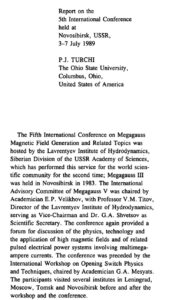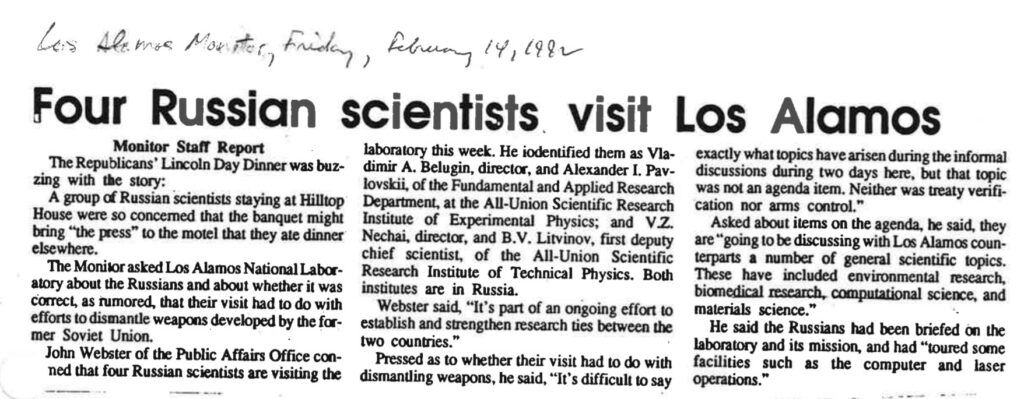Lab-to-Lab: US-Russian Lab-to-Lab Collaboration Story [Archived]
< Back to Interviews
Conversation with Retired LANL Physicists Dennis J. (Denny) Erickson and Paul C. White
1 February 2017, Los Alamos
DE: Denny Erickson; PW: Paul White; AK: Alla Kassianova
Read the interview in PDF
AK: Denny, since you were instrumental at the very beginning of the Lab-to-Lab contacts and you wrote a detailed account for the book, I’d like to learn a little bit more about your personal view on those events. So, at first you were involved on the science side…
DE: My initial interaction with Soviet scientists came in 1979. As a member of a Laboratory team headed by C. Maxwell (Max) Fowler, I participated in a Washington, DC conference on the generation and use of megagauss magnetic fields. The conference was intended as a follow-on to the first international gathering on the subject held at Frascati, Italy in 1965. Max Fowler was one of the featured principals. The Frascati participants were to have included Soviet Academician Andrei Sakharov and colleagues. As preparation for their participation, Sakharov had submitted papers for conference presentation. Ironically, Sakharov and colleagues were not allowed to attend and their papers were withdrawn. The papers, however, were published elsewhere in accessible journals. One important consequence, then, of the Frascati conference was the documented and pioneering efforts of both the Sakharov and Fowler teams in their use of explosive-driven flux compression generators for production and application of ultrahigh magnetic fields. As to the 1979 conference, two Soviet scientists were in attendance and very active. Both were members of the conference organizing committee and readers of papers from numerous Soviet institutes. The Washington, D.C. conference ended dramatically with announcement by the two Soviet scientific leaders to hold the next related conference in the Soviet Union. With this commitment, the announcement formalized the Megagauss Conferences of which the 1979 meeting was dubbed MG II. As testament to the subject, the periodic Megagauss Conferences have continued over the decades bringing together an eclectic group of international participants with strong participation from Soviet/Russian institutes and U.S. laboratories. So, as a young scientist who was establishing a reputation in the subject, my first involvement with Soviet scientists was privileged to be with these two representatives.
PW: Do you remember the institute or organization with whom they identified?
DE: The two Soviet MG II representatives were Vladimir Titov and Gennady Shvetsov from the Lavrentyev Institute of Hydrodynamics in Akademgorodok, the Siberian “Science City” in Novosibirsk. Titov was the Lavrentyev Director. Shvetsov, who spoke excellent English, was an Institute scientist. Our friends Titov and Shvetzov, along with the then “mysterious” Alexander Pavlovsky, were the organizers of the third Megagauss Conference held in the summer of 1983 at the Institute of Hydrodynamics. I think it was at MG III that we met members of Pavlovsky’s team, but not Pavlovsky himself. We also met his contemporary and, perhaps, his scientific competitor Vladimir Chernyshev. The two, Pavlovsky and Chernyshev, identified at the time with the Kurchatov Institute of Atomic Energy in Moscow. Additionally, the two are listed as co-authors on the Sakharov papers originally intended for the 1965 Frascati conference, and as lead authors for papers presented at the 1979 meeting. Supposedly, both had been protégés of Sakharov.
AK: Did you know at that time they were protégés of Sakharov?
DE: I did not. For me, confirmation came later in Sakharov’s memoirs published in 1990. Within a section on magnetic flux compression (termed magneto-cumulation by the Russians), Sakharov reflected on the invitation to the 1965 Frascati conference, his desire to be joined by Pavlovsky and Chernyshev, and his government’s denial of permission. He also notes, perhaps in contrast, Max Fowler’s participation from Los Alamos.
If I could, let me jump ahead. At the conclusion of MG III in Novosibirsk, Max Fowler announced the willingness of LANL to host MG IV in Santa Fe in 1986. I shared with Lab colleagues organizational and coordination responsibilities for MG IV and arranged many of the conference logistics. MG IV attracted 250 attendees from laboratories across the world including those from the US; from European countries, Japan, China and Israel; and from the USSR. A unique tour was arranged to one our explosive testing facilities used for magnetic flux compression experiments in the Laboratory’s high-security Ancho Canyon site. In arranging permission with the Department of Energy, we were told to consider such permission special and not a precedent. Reflecting back some three decades, this event really was a precedent. It was this conference in Santa Fe where hosting skills were learned for later use in the Directors Exchange.
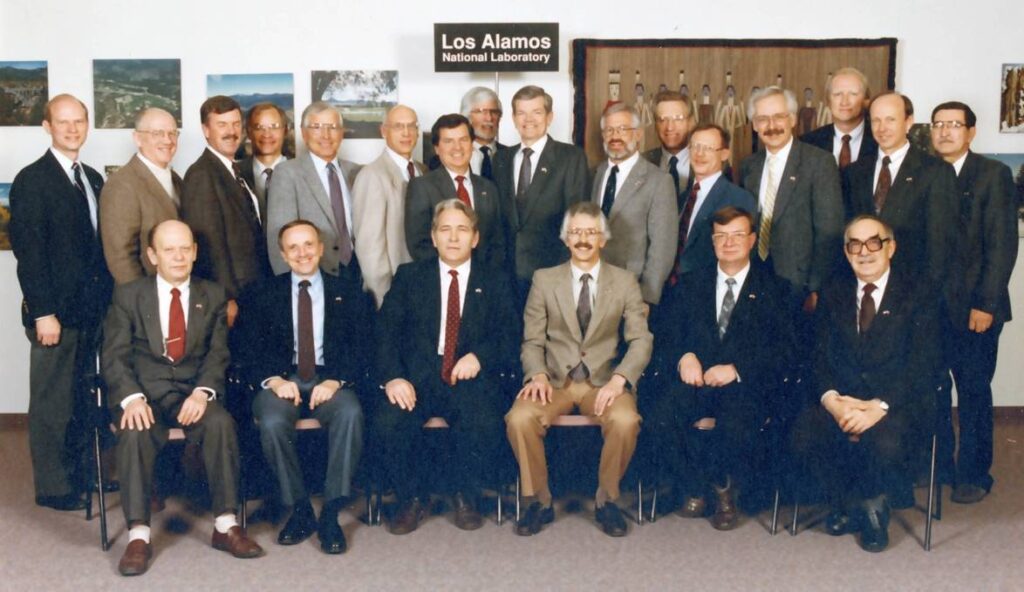
LANL hosts Russian lab directors. 12 February 1992. Seated left to right: Alexander Pavlovsky, VNIIEF, Jim Jackson, LANL, Vladimir Belugin, VNIIEF, Sig Hecker, LANL, Vladimir Nechai, VNIITF, Boris Litvinov, VNIITF. Official LANL photo.
AK: Could you tell us what was learned?
DE: An important challenge involved the importance of hospitality and how to reciprocate. When we visited the Soviet Union in the 1980s and during my last trip to what had become the Russian Federation in 1993, we were guests of the USSR/Russian Academy of Sciences. Because of our status, the hospitality and care shown to us was superb. We then, given our turns, wanted to extend similar hospitality but within our own cultural means and traditions.
Another challenge involved the then Soviet perception of the US and how to counter it with people-to-people reality. The 1980s were still a time when the Soviet people viewed the US based on propaganda fed to them over the years. They were taught to believe Americans were not as well off as they were, and our country was not as democratic and open as it was. The perception was reinforced as most Soviet visits had been concentrated on the East Coast where travel was not allowed internally. One memory shared by Soviet colleagues involved a daylight flight from Chicago to Albuquerque. As they looked down, they saw well-organized farms stretching for hundreds and hundreds of miles. Their impression was maybe the US really was a different kind of place contrary to long-standing propaganda. Another perception changer involved the abundance experienced in our supermarkets and department stores. These places were absolutely amazing to our guests. And as you well know, our Soviet visitors would bring empty suitcases that would be jam-packed for return home with purchases from discount stores such as Kmart.
Yet another important lesson was the need for professional interpreters. In preparation for Santa Fe, we learned how to access the State Department and contract for this special expertise.
PW: Let me try to capture or elaborate, or get you to elaborate, on the US style of hosted conferences whose primary objective is technical exchange. Our style does not necessarily feature hospitality on a personal basis. That’s the issue. There’s a dimension that goes beyond the technical interchange. And I think what you’re saying is we’ve learned how to do that.
DE: Through our participation in the Megagauss Conferences, we had opportunity to develop friendships with our Soviet counterparts. During our times in the Soviet Union, we were often invited into homes for wonderful dinners. The friendships were further developed during follow-on tours in which we spent several days in what is now St. Petersburg and then in Moscow touring the sights and getting to see various institutes.
A memorable example of dinner-time hospitality goes back to (I believe) our first visit in 1983. During the post-conference time in Moscow, Valentin Demichev hosted a dinner for some 20 people in his Moscow high-rise apartment. Demichev was a Kurchatov scientist and member of both the MG III Organizing Committee and the MG Conference International Advisory Committee. He was later to attend MG IV in Santa Fe. It was at that dinner when our host honored and delegated me as the evening’s “tamada.” A tamada serves as tablemaster for a festival dinner such as the Demichev evening. As explained to me, the tamada is the dictator of the table, responsible for assuring everyone has a chance to speak and pacing the flow of toasts. The tamada, much to the relief of the host, closes down the evening. According to tradition the tamada is expected to be eloquent, intelligent, sharp-witted and quick-thinking, with a good sense of humor. Whether being a tall Scandinavian with a gracious personality satisfied the expectations remains debatable. Anyhow, what a great tradition!
A similar event occurred during the 1989 MG V Conference held again in Novosibirsk. Evgeny Bichenkov, another Lavrentyev scientist and also a member of the MG Conference International Steering Committee, hosted a dinner in his family’s apartment. Since Evgeny’s wife and family were away, his neighbors contributed the meal and shared vouchers enabling the evening’s libations, which were then subject to national rationing. It was truly gratifying to see the proud and joyful faces of the Bichenkov friends as they took turns peeking into the apartment to see the results of their gifts.
As a consequence of such occasions, we reciprocated when our Soviet colleagues visited Los Alamos in the mid-1980s. I remember a party in Lab physicist John Shaner’s home. The occasion challenged our friends’ strongly held perceptions of Americans. Even at that time, they found it hard to believe that the Shaner home was a private residence, thinking rather it was a Laboratory “show home.”
Another culture-building gesture by the Americans came from requests for some of us to bring our wives to the Soviet-hosted MG Conferences. Such an exchange began in 1983 at MG III, where Max/Janet Fowler and Denny/Mary Lou Erickson ventured from Los Alamos, Ron/Nancy Hawke from Livermore, and Fritz/Trudi Herlach from Leuven, Belgium. Initially, our hosts did not know what to do with our spouses but quickly and graciously accommodated. A consequence of our gesture was our chance to meet the spouses and children of some of our Soviet peers.
AK: How many Russians came to the 1986 MG Conference in Santa Fe?
DE: Six Soviets attended, including Titov and Shvetsov from the Institute of Hydrodynamics, Demichev from the Kurchatov Institute, and pulse power guru Gennady Mesyats from the Ural Science Center in Sverdlovsk.
AK: How did you select people? Did you send personal invitations?
DE: By then there was an International Steering Committee that guided these meetings. The Committee at that time included strong Soviet representation with Bichenkov, Chernyshev, Demichev, Pavlovsky, Shvetsov, Titov and Evgeny Velikhov (from the Kurchatov Institute) as members. Open invitation mailings were distributed to scientists identified from previous conferences, Steering Committee recommendations, and personal networks.
AK: So you sent more invitations than the actual number of people who eventually came.
DE: Yes. We did so to sustain and grow interest in the conferences knowing that travel restrictions to the host country would self-limit attendance. The MG Conferences were never large meetings. Typical attendance averaged several hundred scientists. The meetings were and continue to be right-sized meetings with ongoing opportunities to both meet personalities and renew acquaintances. So, leading to the 1992 Lab-to-Lab exchange, there was one more MG Conference of note. As commented earlier, the Institute of Hydrodynamics had agreed to host MG V, so we again journeyed to Novosibirsk in the summer of 1989. It was there we had opportunity to finally meet and interact with Alexander Pavlovsky and to deepen relationships with Chernyshev.
AK: So that was the first time they showed up together?
DE: Pavlovsky and Chernyshev were “movie star” characters for many of us. As to Pavlovsky, he was prominent throughout MG V, beginning with his keynote overview and continuing with presentations of papers. Both were fully accessible, engaging and prolific participants. One could talk to them, ask questions, and walk the streets of Akademgorodok in conversation. Pavlovsky, understandably, was a favorite photo-op for many of us Americans.
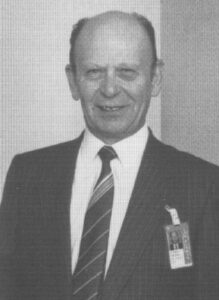
Alexander Ivanovich Pavlovsky, VNIIEF
AK: And was MG V the occasion that your friendship with Pavlovsky became personal?
DE: At that time, I was no longer a member of the Fowler team, having accepted responsibilities as the Lab’s Division Leader for Dynamic Testing. In this capacity, my responsibilities for the MG Conferences had changed to those of institutional champion, member of the International Steering Committee, and ranking member for the Los Alamos delegation. In addition to my past scientific and organizational contributions, I sensed that Pavlovsky knew of my new standing and respected me for it. From that time forward, I really enjoyed Pavlovsky and considered him a special friend. I observed during MG V and later that his demeanor softened when he met special friends such as Max Fowler. I enjoy thinking I was one of those people.
PW: Did you see Pavlovsky again?
DE: Yes, I believe on three occasions. The first was at an IEEE Pulsed Power Conference in Albuquerque during which a rump session of the MG International Steering Committee accepted the offer of Sandia National Laboratories to host MG VI. The second was during the Directors Exchange in early 1992. The final occasion was in Albuquerque at MG VI in November 1992, during which Pavlovsky and Max Fowler keynoted the conference.
PW: Part of the reason I ask is that Pavlovsky’s first visit to Los Alamos may have been for the exchange visits by the Lab Directors in February 1992.
DE: It was.
AK: So you developed friendships with Russian scientists?
DE: MG Conference friends included Shvetsov, Bichenkov and Titov from the Lavrentyev Institute, and Pavlovsky, Chernyshev and Demichev, who until 1991, identified themselves as from the Kurchatoff Institute.
Then comes the fall of the Berlin Wall in 1989 and the dissolution of the Soviet Union in 1991. As I commented in my Reflections contribution in Doomed to Cooperate, Lab Director Sig Hecker called me to his office in late December 1991. I was then serving as the Deputy Associate Director for Nuclear Weapons Technology. Given that Sig had been charged by Admiral Watkins to arrange an exchange with the directors of the now Russian Federation nuclear weapons institutes, I was assigned to see what could be done to coordinate events for such an exchange. And, like so many things in which Los Alamos found itself involved, we did the impossible.
PW: But Sig knew of your involvement with the Russian scientists and, therefore, he thought you knew how to do this.
DE: Yes, that is true. I like to think, however, Sig gave me the assignment because of my reputation for doing difficult things, including my leadership work in the DOE Tiger Team assessment. That assignment gave me nightmares at the time, but I pulled it off. Then came the Directors Exchange with its intense staff work, negotiations, arrangements, support for the Los Alamos visit in February 1992, and the drafting of Sig’s post-visit report.
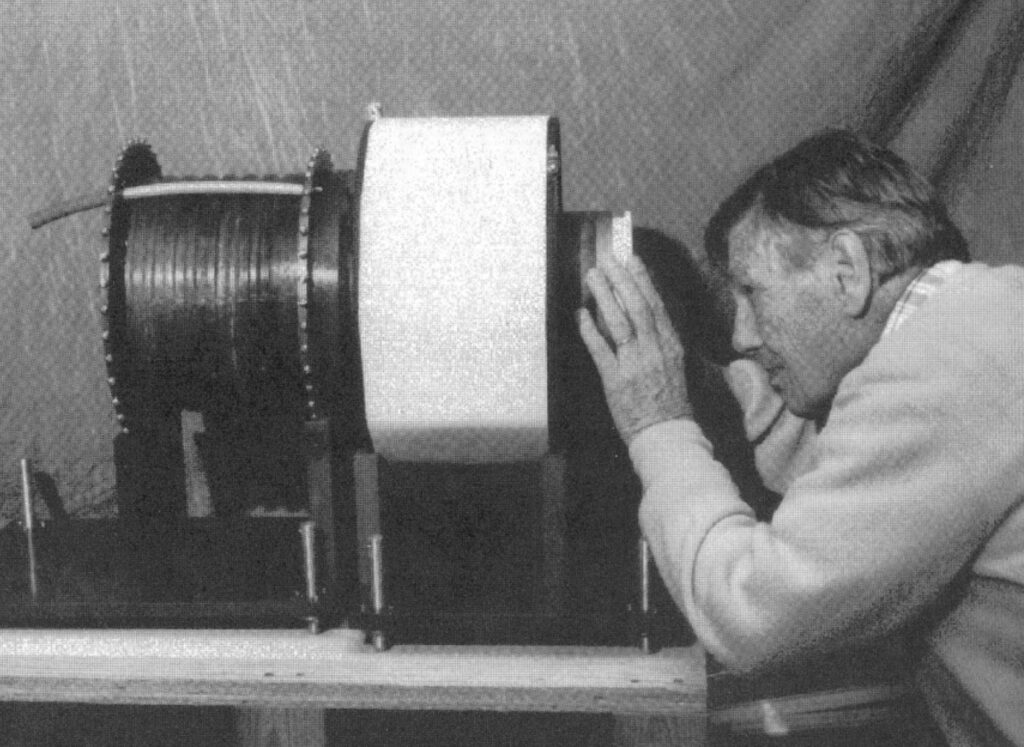
C. Maxwell (Max) Fowler, LANL
With my Directors Exchange assignment completed, I had one final interaction with the Russians. In March 1993, I traveled to Sarov for the first time. Formerly known as Arzamas-16, Sarov was now identified as the official home of the Russian Federal Nuclear Center (VNIIEF) and the true institutional home of Pavlovsky and Chernyshev. As a deputy associate director at the time, I was approving visits to Sarov during the early spin-up of Lab-to-Lab research efforts. Knowing Lab colleagues were collaborating with my Russian friends, I decided to join one of these visits in my role as institutional sponsor. Unexpectedly, my visit was touched by sadness. Just before our departure, we learned that our friend Pavlovsky had died of a heart attack. Alexander Pavlovsky, our esteemed friend only in his mid-60s, was gone. His death came only a year after he and Director Vladimir Belugin had teamed to represent VNIIEF in the historic Directors Exchange. For me, the air went out of the US-Russian collaborations. After a few more years of nominal involvement in the MG Conferences, and having taken another institutional assignment, I gave up my role on the International Steering Committee and left the subject.
AK: When Pavlovsky was here as part of the Directors Exchange in 1992, did you have time with him?
DE: Other than some perfunctory welcomes and greetings, and perhaps some brief catching up, there was no opportunity for informal conversation as I was consumed in making the visit work.
PW: I’m sure it wasn’t regarded as opportunity for personal conversation, but you were in fact the host of the welcome dinner for the Directors Exchange visit to Los Alamos. Part of the story is in your Reflections chapter in Doomed to Cooperate. I was a member of the contingent who arrived that afternoon in Los Alamos and attended the dinner that evening. I remember quite clearly when Pavlovsky and Max Fowler greeted each other, they were like long lost brothers.
DE: As you remember, the contingent including the Russian delegations from Sarov and Snezhinsk arrived in Los Alamos by charter flight on a cold and breezy late Wednesday afternoon on February 12, 1992. The visit followed the initial exchange visit at LLNL. After transport and check-in at the former Hilltop House hotel in Los Alamos, our Russian guests and others gathered for dinner at a long table in the hotel’s Trinity Site restaurant. It was there that Pavlovsky and Fowler greeted each other. For me, it is interesting, especially in the technical world, that accomplished scientists are often more respected and honored by others outside of their own institutions or laboratories. In this regard, Max was viewed as legendary by the Russians and Pavlovsky equally so by the Americans. It was always special whenever they were together.
PW: What was memorable from the welcome dinner?
DE: As noted in my Reflections, Hecker and Lab Deputy Director Jim Jackson were unavailable that afternoon and early evening. In their absence, I served as the Los Alamos host. DOE permission for these visits came with certain restrictions including no public explanation as to the identity of our visitors and no public mention of the purpose of the visits. As a consequence, there were no formal introductions at the table. There was also extreme alertness to prevent any conversation with the public. Given these restrictions, I was terrified that something compromising was going to happen. Again as note in my Reflections, there were two other happenings in the restaurant that February evening. One was the annual celebration of what was then called Lincoln Day, now called Presidents’ Day. Per tradition, the local Republican Party gathered somewhat raucously in the restaurant’s mezzanine for an address (as I remember) by Senator Pete Domenici. So as the Lincoln Day celebration proceeded, I discovered the diner sitting directly behind me across the aisle from our table was the managing editor of our local newspaper, the Los Alamos Monitor. Having a healthy respect for the editor’s reporting capability, I was acutely aware that if she picked up on any of our table conversation, she would come and ask me “So who are these people?” Fortunately, the situation passed as she left following her dinner. However, a day after the conclusion of the Los Alamos visit and departure of our visitors, there was a buzz about some kind of curious visit by Russian scientists.

Denny Erickson hosts welcome dinner for the Russian Lab directors. Seated from L to R: Vladimir Belugin (VNIIEF); interpreter; Vladimir Nechai (VNIITF); Alexander Pavlovsky (VNIIEF); Max Fowler (LANL). Standing: Denny Erickson and late-arriving Deputy Director Jim Jackson (LANL). Photo by Paul White.
AK: Oh, there was a buzz?
DE: Yes, but perhaps only a small one. Following the visit, there was a short blurb in our local paper with vague mention of “there seemed to be a delegation here.”
AK: Do you remember how the visitors felt at the start of the Los Alamos visit? They were just off the plane and looking how?
DE: The Russian directors and their colleagues were very gracious and excited to be here. They had their time at Livermore and now the time had come for Los Alamos. As always and knowing that this Directors Exchange was Sig’s show, there was the usual underlying competition between Livermore and Los Alamos. Since Livermore was first up, LLNL was very careful and diplomatic in how they interacted with the Russians.
PW: Reserved perhaps?
DE: I was told our Livermore colleagues were very concerned about how to present themselves, including who presented, how they would speak, and what to say and what not to say. The visit was apparently quite formal. (See the agenda of the visit) So when the Russians arrived, typical of Los Alamos, the atmosphere from the beginning was much less formal, although within the constraints of the rules, restrictions and boundaries.
PW: I am glad you brought that up because I’ll share my anecdote about the Livermore visit. I was one of three people that you and Sig tasked to go to Livermore on behalf of Los Alamos. We were expected to be “flies on the wall” and observe. The other two were Jim Kowalczyk, who spoke fluent Russian, and Danny Stillman. And just as Denny says, the atmosphere at Livermore was formal. As Livermore guests, we three strictly followed protocol, but found ways to crack the façade of formality.
Since we were staying in the same hotel as the Russians, we had occasion after the meetings and early in the morning at breakfast to socialize. During the Livermore sessions, there would occasionally be Russian requests for interruptions such as the need to make a phone call. Whatever the request for a break, what they really wanted was time to step outside and smoke. And as the Russians went outside, the senior Livermore people including the LLNL Director would leave the briefing room, take the elevator up to the Director’s Office, and discuss what to do during the next session. During these pauses, the three of us from Los Alamos would go outside, stand in the cloud of smoke, and chat with our Russian counterparts. So we were already establishing a kind of personal, let’s just say, way to cut the barriers of formality. And I remember talking to you, Denny, the night before we flew from Livermore to Los Alamos on a DOE plane. You drew out of me all these bits and pieces to help shape the Los Alamos visit, which I believe was conducted in a way culturally different from Livermore. I also believe such an approach followed Sig’s instinct to cut formality and focus on relationships. Returning to the night before the flight, the Russians invited us up to Belugin’s hotel room where they broke out the Armenian brandy, convinced that if we had just one more glass of brandy, we would understand their jokes.
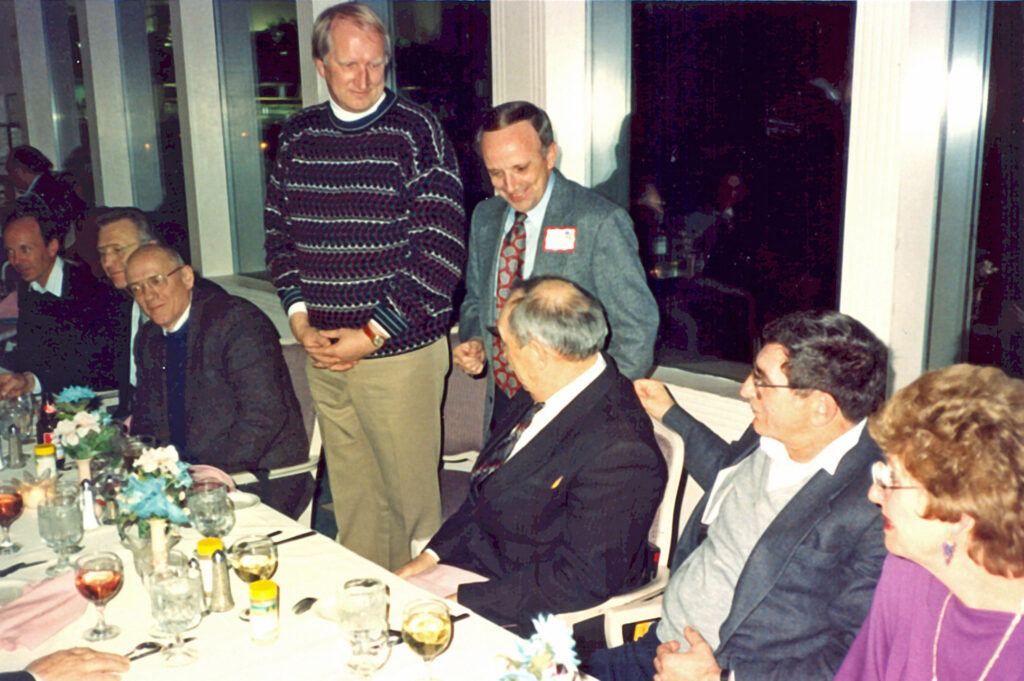
Denny Erickson and Deputy Director Jim Jackson (LANL) address guests at the welcome dinner for Russian Lab Directors. Los Alamos, 12 Feb., 1992. Photo by Paul White
DE: Frankly, I never have understood Russian jokes. Your mention of brandy brings back other memories of hospitality from previous visits to the Soviet Union. The MG Conferences always included social events. An example in Novosibirsk was a boat trip on the Ob Sea and an onshore picnic. I remember well the excellent Georgian red wine, Russian vodka, and Armenian cognac, which I especially enjoyed being a scotch drinker. And there was great food at picnic tables. Usually the Soviet research teams got there first as the food and drink were a big deal for them.
AK: Back to the Los Alamos visit. What about interpreters?
DE: As Paul mentioned, Russian-speaking Jim Kowalczyk from Los Alamos was with the US Directors Exchange, I believe, from beginning to end.
PW: Livermore had their own interpreters using Russian-speaking staff.
DE: Here, in addition to Kowalczyk, we had contracted through the State Department for two professional interpreters who worked the sessions and presentations.
AK: At the welcome dinner, did you speak in hushed voices for fear of being heard?
DE: As to the gathering around the table, no guidance was given. As for me, I am naturally soft spoken and was even more so that evening. I used care in every word I spoke. The table conversation was generally in English. Pavlovsky spoke very good English. Institute Directors Belugin and Nechai, and the VNIITF Chief Scientist Boris Litvinov not so good.
AK: Paul mentioned you had a phone conversation the night before the group moved from Livermore to Los Alamos. Did you use this conversation to refine your agenda or just to make sure that you had all the available information?
DE: Frankly, I don’t remember that conversation but am grateful for it. However, I did want a summary of how Livermore handled and scripted their visit versus what we were prepared to do. Our security plan was sanctioned and ready for implementation. Our escorts were identified and briefed. Our presentations were reviewed and complete. Our technical site tours had been selected and approved. Our hospitality functions were in preparation. I guess at the time, in addition to the stress of anticipation, I was curious as to the sociology of the group and the willing engagement of the Russians.
PW: That was really my recollection of the substance of the conversation. The bottom line being that we should engage our guests personally and frankly. As we were to find out, the focus on engagement was more important than details of where we visited, what sites were seen, and what presentations were given. That late-night conversation reinforced mutual understanding as our objective for the Los Alamos visit.
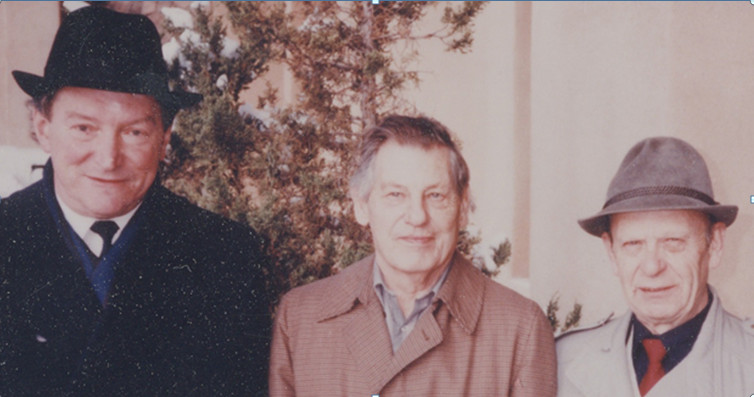
Vladimir Chernyshev (VNIIEF), Max Fowler (LANL), Alexander Pavlovsky (VNIIEF). Megagauss VI, Albuquerque NM, November 1992
AK: Were you present throughout that entire visit?
DE: Of course, I experienced the entire program. I am one of those curious people with both a strategic feel and a concern about quality of detail, trusting others for the work in between. We had the Lab’s best protocol person, Ann Gajewski, to arrange the details. I spent time where necessary assuring that people understood their assignments.
I do think, bottom line, the experience was truly enjoyable, especially given the significant strategic importance driving the exchange. In addition both the Livermore and Los Alamos visits were not only historic but exotic. In this regard, I am proud Los Alamos pushed the edge for mutual good. I also think in so doing we conducted our visit within agreements with the DOE, granting that our requests were certainly beyond comfort levels. However, we had full cooperation from the appropriate DOE offices. This was a great visit appreciated by all. I also believe the Los Alamos visit set the stage for the Russian exchanges that Sig, Livermore Director John Nuckolls, and colleagues made two weeks later. While at Los Alamos, and unlike at Livermore, the Russians went into classified work spaces such as our Central Computing Facility, Detonator Engineering Facility, and Ground Test Accelerator Facility used in support of the BEAR test. (See the agenda of the LLNL visit) These facility encounters established a kind of quid pro quo reciprocated by the Russians. For example, I know for certain VNIIEF opened up just like we did. A lesson learned from our exchanges over the years is that Russian scientists from both design institutes, not unlike their US counterparts, are proud of their capabilities. They love to show what they do and how they do it. For years, we speculated about what they were doing design-wise and facility-wise. What we discovered during the Directors Exchange and the subsequent Lab-to-Lab collaboration was the best way to find out something we didn’t know was to sit across the table and ask.
A related anecdote comes from the reception during the Los Alamos visit. The reception was held in the Bradbury Science Museum, which at the time was located on Lab property adjacent to our Administrative Building. During the reception and in conversation with Sig, VNIIEF Director Belugin said he was so taken by our museum that Sarov needed to have one. And sure enough, thanks to Belugin’s inspiration, they moved expediently to create one. I saw the Sarov weapons museum in its early stage in 1993. Frankly, I was taken aback by both what we saw and the fact Belugin had expedited his commitment made in Los Alamos.
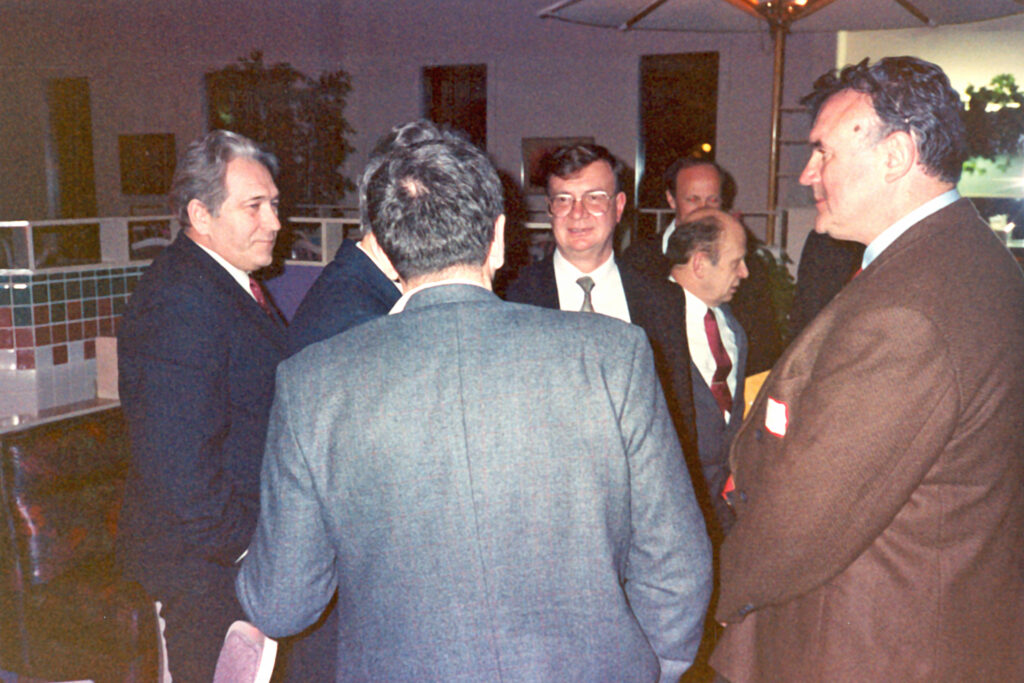
Russian visitors in their first night in Los Alamos. Seen in the picture are Vladimir Belugin, Vladimir Nechai and Alexander Pavlovsky. Photo by Paul White
PW: Did you know there was further interaction related to museums because Belugin sent over their museum director?
DE: I did not know that.
PW: The VNIIEF museum director spent an extended visit with our Bradbury Director John Rhodes, camping out with Rhodes for two-three months to learn how to craft exhibits, arrange a museum, and tell the VNIIEF story. Part of Belugin’s comment at Los Alamos was that half of the people in Sarov did not know what the people of his institute did nor the importance of their work. Belugin was committed to telling the story.
As a footnote to the Belugin anecdote, I was chatting during the reception with VNIITF Chief Scientist Litvinov through the help of a Russian-speaking colleague. During our conversation, I looked up and there, directly above our heads, was an aero-shell for a Los Alamos warhead. So I asked Litvinov, “Do you have a museum like this in Snezhinsk?” Litvinov responded “If we do, they have not told us.”
AK: Denny, did the Russians ask many questions during the Lab presentations? Who asked the questions and what kind of questions were they?
DE: All four of the Russian leaders asked questions, knowing that simultaneous translation was being provided. However, Pavlovsky asked the majority of technical questions. He did so because of his English proficiency, experience as an experimentalist, past interactions in international environments, and, perhaps, sense of comfort knowing several of us. Such questions were either his own or prompted by side conversations with colleagues. Belugin asked his share of questions that were generally procedural or operational. VNIITF Director Nechai might have been the quietest of the four. However, he was always thoughtful, diplomatic and courteous. That he was favorably impacted by the Directors Exchange was evidenced by the institutional gift presented to Sig on the occasion of Lab’s 50th Anniversary in 1993. The VNIITF gift was special as it was a mounted piece from a destructed Soviet SS-11 missile.
AK: And were there social events in the Los Alamos program?
DE: Of course and in my judgement these gatherings reciprocated the hospitality shown to us in Russian venues. The first was the welcome dinner at the Hilltop House on Wednesday evening. On Thursday afternoon, following the program events, we hosted the reception at the Bradbury Museum. Thursday evening concluded with an excellent sit-down dinner hosted by John and Jackie Immele in their Los Alamos home. John was our Associate Director for Nuclear Weapons Technology. He, along with John Shaner, joined Sig for the exchange visits in Russia. The Los Alamos visit concluded with a catered dinner on Friday evening in the Laboratory cafeteria, after which the Russian delegation was transported to Albuquerque.
AK: Were any DOE people present during these visits?
DE: I don’t recall their presence.
PW: Not officially. However, they may have been present during some of the presentations and conversations.
AK: So they trusted the laboratories, Los Alamos and Livermore, to conduct the visits without oversight?
DE: I don’t think it was trust. I think it was more fear of association on their part, especially in the event of an embarrassing incident or compromise.
PW: Exactly. They wanted and needed separation.
DE: Such separation was not unusual for the design laboratories, which continue in their customary willingness to assume risk in the national interest. The direction given to Sig Hecker by Admiral Watkins to arrange the Directors Exchange clearly placed the responsibility and risk for the venture with the Los Alamos and Livermore Directors. Therefore, there was no formal introduction or involvement of DOE people, either from Los Alamos, Albuquerque or Washington, DC.
AK: After conclusion of the visits, was the Directors Exchange considered successful by DOE Headquarters?
DE: Oh yes. In my judgement, the most important consequence of the visits was the willingness for frank conversation and a mutual openness for relationships. After four site visits, two in the US and two in Russia, the directors and their delegations were more than just international colleagues, they were respected peers. I’m not sure one would call them confidants, but they were certainly individuals that could ask hard questions and expect forthright responses. If you look at what Sig did personally in the next 15-20 years of Lab-to-Lab collaboration, he consistently asked challenging questions and just as consistently got meaningful responses. Another event that preceded and underpinned this consequence was the Joint Verification Experiment (JVE) in 1988, which established a powerful and courageous precedent for scientist-to-scientist cooperation. These two events, the Directors Exchange and the JVE, set the stage for the Lab-to-Lab programs in the succeeding decades.
AK: Were you involved in the JVE?
DE: Only in that my organization provided expertise for the JVE and the associated Nuclear Testing Talks.
AK: When you visited Sarov in March 1993, you say this was your first time there. Who else came with you?
DE: As noted in my Reflections contribution, our Los Alamos delegation was headed by Steve Younger. The assignment was to negotiate a collaborative exchange featuring explosive pulsed power experiments using magnetic flux compression. Steve, then as now, is a mission-focused person. Thanks to his hard-driving leadership, the negotiation was successful, enabling the first joint Los Alamos-VNIIEF experiments later that year. Also in the delegation were Los Alamos scientists and Fowler colleagues Bob Reinovsky, Irv Lindemuth, Jim Goforth and Carl Ekdahl.
AK: Tell us about your impressions on entering Sarov and being there, interacting with people.
DE: My first impressions on landing in Sarov included snow, security, barbed wire and the controlled entry into the town. Such impressions were not unlike those of visitors to Los Alamos in the early decades of the Laboratory.
AK: So you flew in directly from Moscow?
PW: There is indeed an airfield in Sarov, and a twin engine turbo plane that brought Denny and his colleagues to VNIIEF.
DE: After landing, we were taken to the Science Hotel in Sarov, the same hotel in which the Los Alamos/Livermore delegations stayed in February 1992. Across the street from the hotel was the track on which Sig had run in super-cold weather the year before. Since it was high winter in Sarov, I explained at the beginning that I was a Nordic skier and requested to ski the Russian forest. So every morning during our three-day visit, I asked whether our hosts were able to find skis long enough for me. And every day, the answer came back “No, not yet.” Therefore, skiing the Russian forest remained an unfulfilled experience.
The visit involved many enjoyable activities and an especially sad one. I remember a banquet dinner where seated next to me was the distinguished Academician Yuri Romanov. Our conversation over the evening, which included many toasting rounds, was quite enjoyable. Another fond memory was walking by Sakharov’s former home in Sarov with my Los Alamos colleagues.
Of great sadness was the mourning of Pavlovsky’s death. We were given opportunity to visit his grave where Steve laid a wreath on the tombstone. My request to see the Pavlovsky family was graciously granted. During my short visit with Mrs. Pavlovsky and family, I shared my personal sorrow in losing a special friend. The exchange was truly somber.
The most amazing event of that 1993 visit was triggered by another of Sig’s delegations. I was instructed to request an introduction to the venerable VNIIEF Scientific Director Emeritus Yuli Khariton. The purpose was to present on behalf of Director Hecker a silver medallion and pin commemorating the 50th anniversary of the Los Alamos Laboratory. On arrival in Sarov, I immediately made the request. Khariton, whom I’d read about, was a throwback to the days of Oppenheimer, Kurchatov and others. For somebody like me, a second or even third generation participant in the weapons business, such an exchange would be a significant honor.
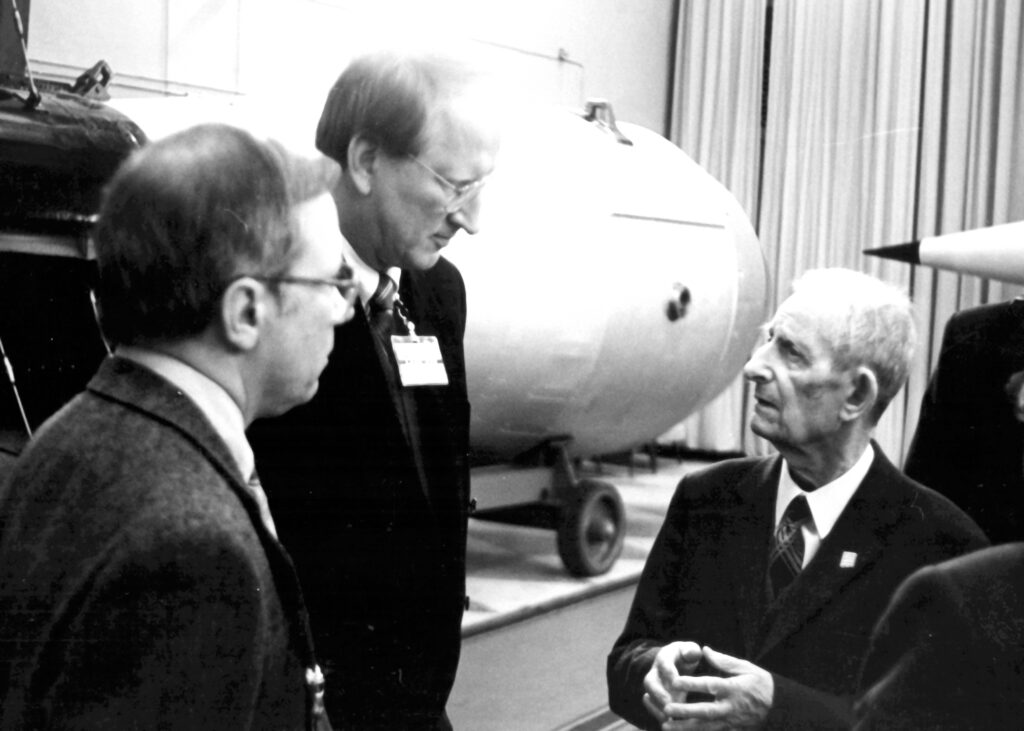
Erickson and Steve Younger in conversation with Yuly Khariton. Sarov, March 1993. Official VNIIEF photo.
Then one afternoon, Younger and I were transported to this brick building in downtown Sarov, which turned out to be the initial location of the VNIIEF museum. Upon entering the building, we were taken to an auditorium, where I met Khariton and proceeded to extend Sig’s greeting, presented the anniversary medallion and attached the commemorative lapel pin. Khariton was quite gracious throughout and conducted the exchange in English. We then walked into an adjoining room filled with weapons models with a wall adorned with framed photos of significant Soviet/Russian academicians, including that of my dinner companion Romanov. So I’m walking around the room and there I see a model of the Los Alamos Trinity device, similar in detail to the scale model formerly featured in the entry to our Administration Building. As we know, the design of the Trinity device was the basis for Joe One, the Soviet’s first atomic test in 1949.
[to Paul White]: Paul, have you been to the VNIIEF weapons museum in Sarov?PW: Yes. Both the one you experienced and the new one.
AK: You were certainly involved in the early stages of the Lab-to-Lab collaborations – late Soviet Union and early Russian phases – and then you said you went on to other things.
DE: After the March 1993 trip to Sarov, I continued to serve as John Immele’s deputy in the Nuclear Weapons Technology Directorate, sharing responsibilities for the Lab’s mainline mission program. In the summer of that year, I was in Europe for a weapons policy tour. The tour started in Brussels, moved to Bonn, and made its way south along the Rheine with visits to US Air Force bases. German reunification, another consequence of changing geopolitics, was a special theme during the tour. That same summer, Sig Hecker committed to changing the organizational structure of the Laboratory. Inspired by the American quality revolution, Sig was preparing to streamline Lab operations by eliminating upper-level directorate management for an expanded division-level approach. In resetting the Lab organization, Sig was also searching for different kinds of personalities to lead the restructured divisions. In response, I offered my credentials for several of the new operational support divisions. I did so because of my experience as a technical line manager for high-hazard operations and facilities. My story moves to the Grand Canyon in the early fall of 1993. While my wife Mary Lou and I were hiking with long-time friends, Sig calls with an offer to lead the Lab’s environment, safety and health organization. Understanding the need and appreciating Sig’s confidence in me, I accepted the offer and became the Lab’s ES&H Division Director. For a Los Alamos physicist whose focus had been on science and technical programs, the new assignment meant I was done doing mainline scientific work including any participation in the growing Lab-to-Lab efforts. What followed were eight challenging years from 1993 to 2001 as the Los Alamos chief for these institutional support functions. Stepping away from this role, I spent a year in a shared-executive assignment as New Mexico Governor Richardson’s science adviser, and another two years on assignment to the University of California Office of President preparing UC for contract competition. As a member of the successful proposal team comprising UC, the Bechtel Group and two smaller companies, the LANS consortium was awarded the M&O contract for Los Alamos to become effective in mid-2006. Ironically, a colleague and I wrote the key organizational and governance section of the winning LANS proposal. Coming off the California assignment, I decided to retire prior to the contract transition, concluding 35 years as a Los Alamos scientist, senior manager and UC executive.
PW: The rest is history.
DE: Looking back, I take pride in having been a member of this world-changing place called Los Alamos. The Laboratory was a great place to work – a place filled with really smart people and well-equipped facilities; a place committed to national service; a place that thrived on tough problems; and a place that interacted across the globe. And in all of this, we have been a place, even though some would argue, that our nation has relied on to keep it and the world safe.
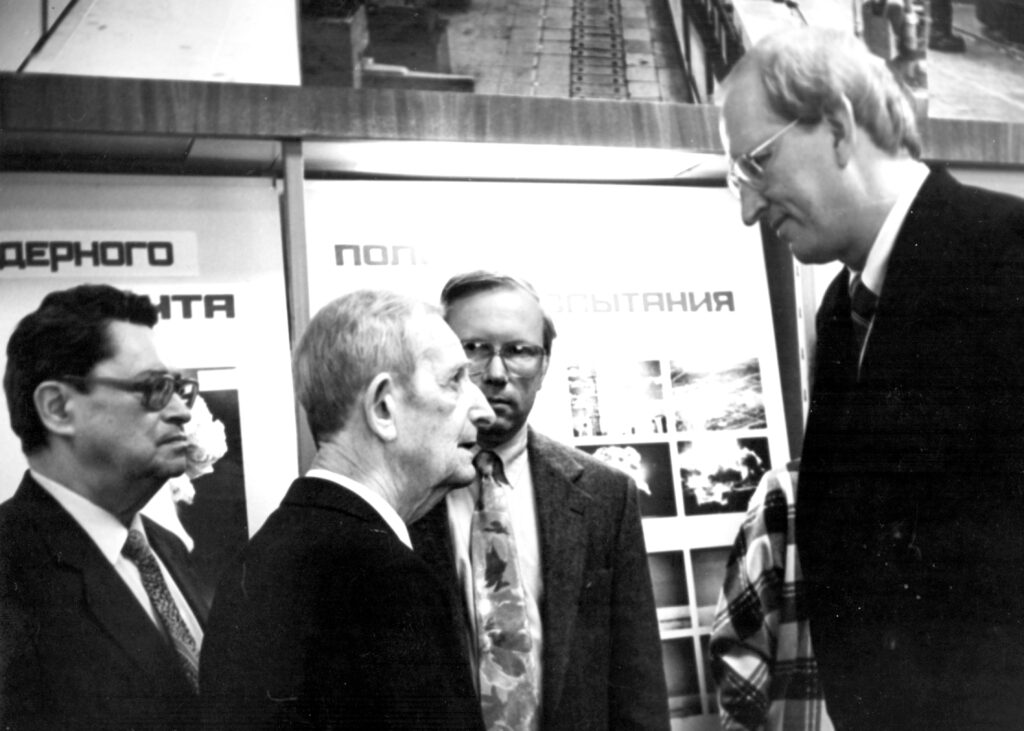
From L to R: Yury Trutnev; Yuly Khariton (both VNIIEF); Steve Younger; Denny Erickson (both LANL). Sarov, March 1993. Official VNIIEF photo.
I also take pride in my work with and for Sig Hecker. Sig was a model for many of us as to commitment and innovative leadership. A special characteristic was his enthusiasm and optimism as Laboratory Director. I remember the many, many times we passed in hallways or at meetings when Sig would greet me with “Denny, are you having fun yet?” My typical response, in the midst of yet another tough challenge, was “Fun? No way!” However, my payoff came in the satisfaction of finding ways through such challenges. As for Sig, he truly enjoyed the challenges in leading our Laboratory. Such enthusiasm certainly helped to motivate and carry the rest of us.
AK: To conclude our interview, how do you regard your role in organizing the Directors Exchange at Los Alamos in this extraordinary career of yours?
DE: I do not consider this particular accomplishment as major because I had, during my Lab tenure, opportunity to confront a multitude of complex challenges, many of which were worked during Sig’s time as LANL Director. Of significance, however, and hence very satisfying, was the consequence the Directors Exchange had in inspiring the Lab-to-Lab collaboration during the subsequent decades as a means to stabilize the world-threatening instabilities of the time. The evolving cooperation that Sig has assembled in Doomed to Cooperate is a magnificent story of talented people collaborating across boundaries, cultures and past histories. That such an endeavor is now slipping away suggests that the Doomed to Cooperate story will be an important legacy that common understanding through scientific collaboration is in fact possible. I suggest without Sig’s compilation, the collaboration would have become a kind of fairy tale. People would say “Not possible, not believable!” However, this carefully documented story provides experiential precedent that people can work to common purpose and make a difference.
Let me finish with a personal lament now resolved. Since I was too young to have been in Los Alamos during the so-called formative time of the Laboratory in the 1940s and 1950s, I’ve always wondered what it was like participating during a period of historical significance. But now looking back, the 1980s and 1990s were indeed historic times for the world and Los Alamos during which I had a part.
AK: So you did. All right, well thank you. It’s always great thing to learn more and to be able to ask these questions that I was always curious about. We do appreciate your coming and sharing your story.
Read the interview in PDF.

